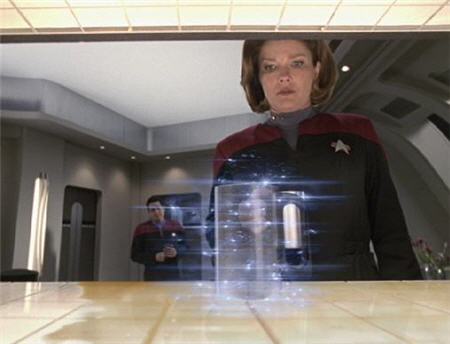Science Fiction
Dictionary
A B C D E F G H I J K L M N O P Q R S T U V W X Y Z
Superfast Replicator: Volumetric Additive Manufacturing

Additive manufacturing promises enormous geometrical freedom and the potential to combine materials for complex functions.
We demonstrated concurrent printing of all points within a three-dimensional object by illuminating a rotating volume of photosensitive material with a dynamically evolving light pattern. We print features as small as 0.3 mm in engineering acrylate polymers, as well as printing soft structures with exceptionally smooth surfaces into a gelatin methacrylate hydrogel. Our process enables us to construct components that encase other pre-existing solid objects, allowing for multi-material fabrication. We developed models to describe speed and spatial resolution capabilities. We also demonstrated printing times of 30–120 s for diverse centimeter-scale objects.We developed a method, Computed Axial Lithography (CAL), that allowed us to synthesize arbitrary geometries volumetrically through photopolymerization. The CAL approach has several advantages over conventional layer-based printing methods. The method may be used to circumvent support structures as it can print into high viscosity fluids or even solids. Printing 3D structures around preexisting solid components is also possible with our approach. CAL is scalable to larger print volumes, and is several orders of magnitude faster, under a wider range of conditions, than layer-by-layer methods.
The CAL manufacturing system we developed selectively solidifies a photosensitive liquid within a contained volume. We delivered light energy to the material volume as a set of two-dimensional images. Each image projection propagates through the material from a different angle. The superposition of exposures from multiple angles (Fig. 1A) results in a three-dimensional energy dose sufficient to solidify the material in the desired geometry. Our process was inspired by the image reconstruction procedures of Computed Tomography...
(Via Science Mag)
Soon, Star Trek TNG and beyond replicator technology will be here and we can all relax, never to shop again. In the fictional series, a replicator can create and recycle objects, synthesize meals on demand, and even allow the crew to shop for and obtain unusual articles that would not ordinarily be stocked on a star ship.

(Star Trek replicator)
I can't wait.
Scroll down for more stories in the same category. (Story submitted 1/29/2019)
Follow this kind of news @Technovelgy.| Email | RSS | Blog It | Stumble | del.icio.us | Digg | Reddit |
Would
you like to contribute a story tip?
It's easy:
Get the URL of the story, and the related sf author, and add
it here.
Comment/Join discussion ( 0 )
Related News Stories - (" Manufacturing ")
DARPA Wants 'Large Bio-Mechanical Space Structures'
'These are your rudimentary seed packages... Some will combine in place to form more complicated structures.' - Greg Bear, 2015
Robot Bricklayer Or Passer-By Bricklayer?
'Oscar picked up a trowel. 'I'm the tool for the mortar,' the little trowel squeaked cheerfully.' - Bruce Sterling, 1998.
Organic Non-Planar 3D Printing
'It makes drawings in the air following drawings...' - Murray Leinster, 1945.
Laser-Beam Welding In Orbital Factories
'His contract with Space Industries required him to work summers in their orbital factory.' - Jerry Pournelle, 1976.
Technovelgy (that's tech-novel-gee!) is devoted to the creative science inventions and ideas of sf authors. Look for the Invention Category that interests you, the Glossary, the Invention Timeline, or see what's New.
Science Fiction
Timeline
1600-1899
1900-1939
1940's 1950's
1960's 1970's
1980's 1990's
2000's 2010's
Current News
Bone-Building Drug Evenity Approved
'Compounds devised by the biochemists for the rapid building of bone...'
Secret Kill Switch Found In Yutong Buses
'The car faltered as the external command came to brake...'
Inmotion Electric Unicycle In Combat
'It is about the size and shape of a kitchen stool, gyro-stabilized...'
Grok Scores Best In Psychological Tests
'Try to find out how he ticks...'
PaXini Supersensitive Robot Fingers
'My fingers are not that sensitive...'
Congress Considers Automatic Emergency Braking, One Hundred Years Too Late
'The greatest problem of all was the elimination of the human element of braking together with its inevitable time lag.'
The Desert Ship Sailed In Imagination
'Across the ancient sea floor a dozen tall, blue-sailed Martian sand ships floated, like blue smoke.'
The Zapata Air Scooter Would Be Great In A Science Fiction Story
'Betty's slapdash style.'
Thermostabilized Wet Meat Product (NASA Prototype)
There are no orbiting Michelin stars. Yet.
Could Crystal Batteries Generate Power For Centuries?
'Power could be compressed thus into an inch-square cube of what looked like blue-white ice'
India Ponders Always-On Smartphone Location Tracking
'It is necessary... for your own protection.'
Amazon Will Send You Heinlein's Knockdown Cabin
'It's so light that you can set it up in five minutes by yourself...'
Is It Time To Forbid Human Driving?
'Heavy penalties... were to be applied to any one found driving manually-controlled machines.'
Replace The Smartphone With A Connected Edge Node For AI Inference
'Buy a Little Dingbat... electropen, wrist watch, pocketphone, pocket radio, billfold ... all in one.'
Artificial Skin For Robots Is Coming Right Along
'... an elastic, tinted material that had all the feel and appearance of human flesh and epidermis.'
Robot Guard Dog On Duty
I might also be thinking of K-9 from Doctor Who.
